Astronomers To NASA: Please, Build This Telescope!
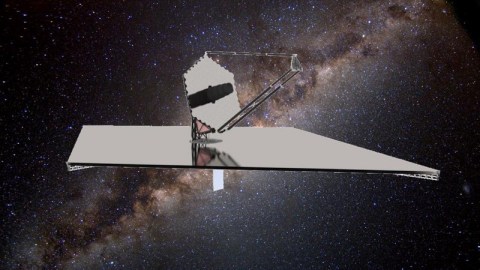
If you want to find life in the Universe, this is how you do it.
When it comes to uncovering the ultimate truths about reality, we can only reap what we sow. Without a cutting-edge particle collider like the Large Hadron Collider at CERN, we would never have discovered the Higgs Boson. Without the incredible sensitivities achieved by gravitational wave detectors such as LIGO and Virgo, we never would have directly detected gravitational waves. And without a revolutionary space telescope like Hubble, the overwhelming majority of the Universe — which has since been revealed to us in exquisite detail — would have remained obscure.
In our quest to understand the Universe around us, we always seek to extract the maximum amount of science possible from whatever tools we choose to build. Once every 10 years, the entire astrophysics community gets together to submit their recommendations for which projects would be of the greatest scientific benefit to the field: part of a decadal survey conducted by the National Academies. These surveys have brought us some of the most iconic missions in history, and have helped advance science like nothing else ever has. In just a few months, they’ll release their decision on recommendations for the four astrophysics missions that made it as finalists. With the results yet to be revealed, there’s one proposed observatory that everyone should know about: LUVOIR. If you’ve ever dreamed about knowing the answers to the biggest questions of all, this is the one telescope that we absolutely must build. Here’s why.

For the past 31 years, NASA’s Hubble has truly showcased for us what a cutting edge, space-based observatory is capable of. Far above the atmosphere of Earth, Hubble:
- no longer has to contend with night-and-day, as it can continuously observe space,
- never has to worry about clouds, turbulent air, bad weather, or natural disasters,
- can always achieve resolutions comparable to the theoretical optical limit,
- can observe at all ultraviolet, optical, and infrared wavelengths, without ever having to worry about molecules in the atmosphere getting in the way,
- and can observe the same patch of sky, over and over, and simply “stack” the observations to see farther than ever before.
In fact, the limiting factor to Hubble’s equipment — the reason it can’t observe at wavelengths longer than about 2 microns, or about three times as long as the limit of human vision — is because it gets heated by the Sun. Just as infrared cameras reveal heat sources, the inside of Hubble is too warm to observe at mid-and-far infrared wavelengths.
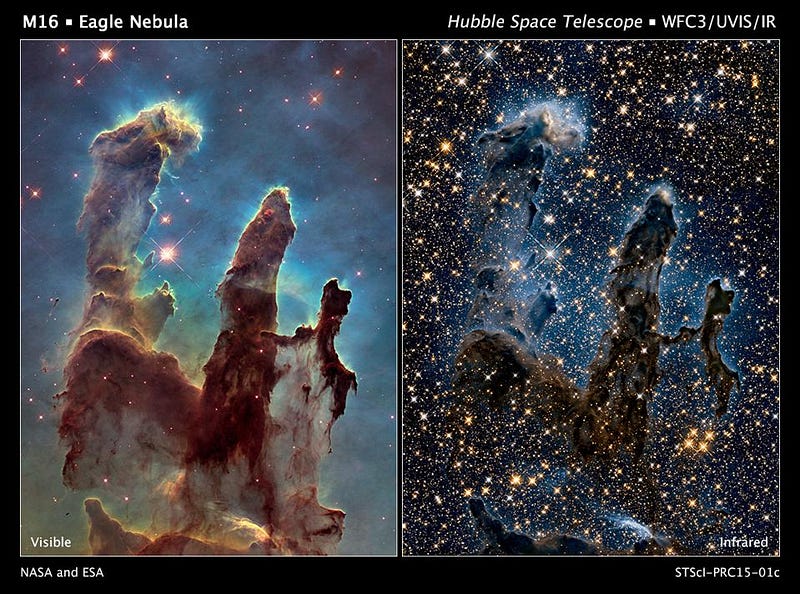
Hubble’s other major limitation is its narrow field-of-view. Even with the most advanced camera ever installed on it, the Advanced Camera for Surveys/Wide Field Camera 3, it can only achieve resolutions of approximately 8 megapixels. When you take into account the mirror size and focal length of Hubble — optical properties that are second nature to astronomers — it can resolve objects down to angular resolutions of just 0.04 arc-seconds, or just one-ninety-thousandth of a degree. If you put the Hubble Space Telescope in New York, it could resolve two separate fireflies in Tokyo if they were separated by merely 3 meters (10 feet).
This makes Hubble outstanding at taking deep, high-resolution observations in the ultraviolet, optical, and near-infrared, over small fields-of-view. Various observing campaigns, like the Hubble Deep Field, Ultra Deep Field, and eXtreme Deep Fields, have taken advantage of these capabilities to reveal what lies out there in the abyss of deep space: thousands upon thousands of galaxies in tiny regions of space that cover mere fractions of a millionth of the sky.
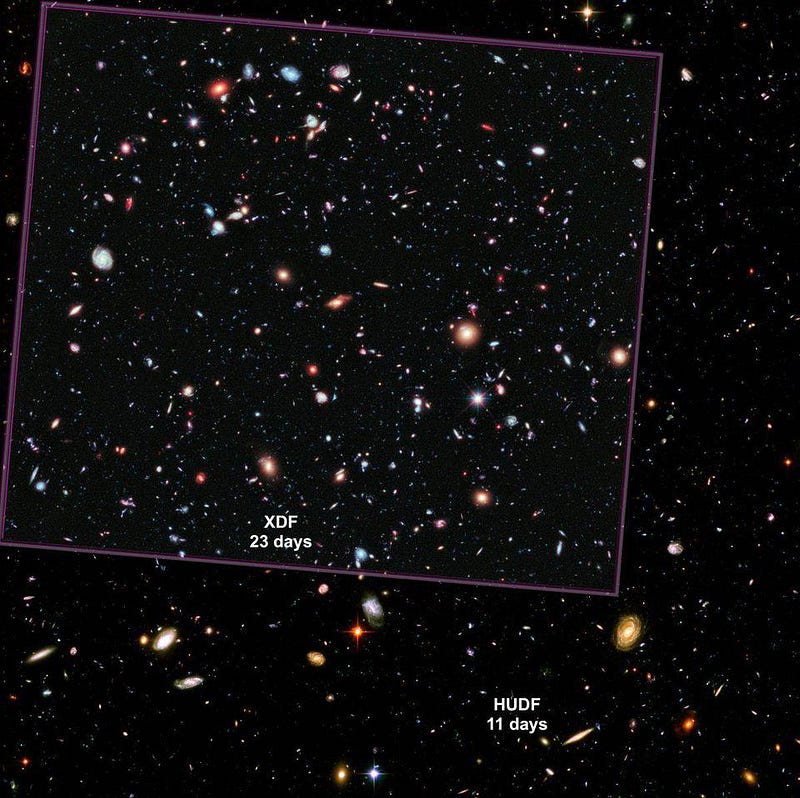
Yet even at the full extent of its capabilities — even with the equivalent of a month of continuous observing — Hubble can still only see an estimated ~10% of the galaxies that are out there. Most of them are some combination of:
- too small,
- too faint,
- too distant,
- and too obscured by neutral atoms,
to be seen by Hubble. Moreover, even the majority of galaxies that are revealed are barely more than a few points, as Hubble is too small in size, with too little resolving power, to reveal additional details. In many ways, Hubble represents the greatest astronomical endeavor ever undertaken by our civilization, but it’s also fundamentally limited.
Over the coming decade, beginning later this year, two additional space-based NASA observatories will launch: the James Webb Space Telescope, which is larger, cooler, and can work with much longer wavelengths than Hubble can, and the Nancy Roman Telescope, which is very similar to Hubble except with wide-field capabilities and much more powerful, state-of-the-art cameras.

These observatories will begin to tackle some of the questions that Hubble cannot answer. With its enormous sunshade, its location far beyond both the Earth and the Moon, its on-board active coolant, and its enormous, gold-coated 6.5-meter primary mirror, James Webb will surpass Hubble on many fronts. Instead of ~2 microns, it can observe wavelengths out to ~30 microns, revealing an enormous suite of science details that Hubble cannot. From the earliest stars and farthest galaxies to details about planet formation and the atmospheric composition of the closest Earth-like planets around the smallest stars, this observatory is truly the next leap forward for space-based astronomy.
The Nancy Roman Telescope, on the other hand, will go broad, wide, and just as deep as Hubble. With its wide-field views, each observation will collect 300 megapixels of data compared to Hubble 8, enabling large, deep, wide-field surveys to be done in just a tiny fraction of the time. Roman will shine brightest when it comes to observing projects like the ones that created the Hubble Frontier Fields or that imaged the Andromeda galaxy. Instead of months of observing time, Roman could do it in mere hours.
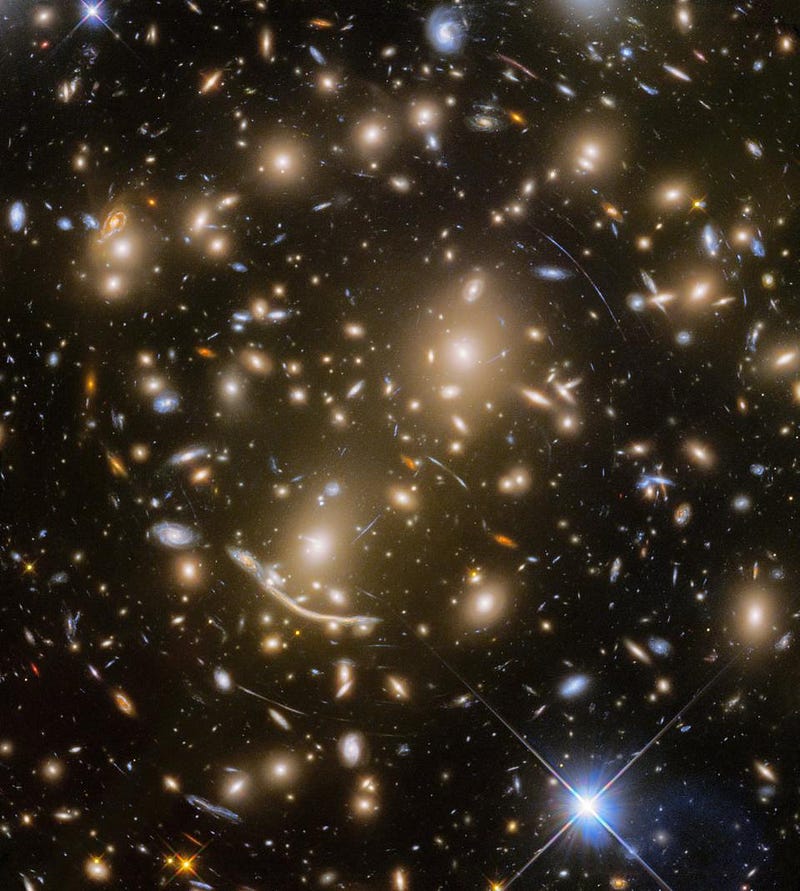
But even with these advances, there are still questions that we want answers to — big, important, even existential questions — that will go unanswered. Even with Webb and Roman, most of the galaxies in the Universe, even in a tiny, narrow region of space, will remain elusive. Most of the galaxies that we do see will still, unfortunately, simply be a few pixels across, with barely discernible structure. And, perhaps most importantly, they won’t have the ultimate capabilities of a space-based observatory: the ability to directly image Earth-sized planets around Sun-like stars, and to identify which ones might not only have signatures for life, but might actually be inhabited.
There is one telescope that’s been designed that could accomplish all of these, and it’s one of the four finalists to determine what NASA’s plan for astrophysics flagship missions will be for the 2030s: LUVOIR.

What is LUVOIR?
It’s the Large UltraViolet, Optical, and InfraRed telescope. Basically, you should imagine a version of the largest functional ground-based telescopes we have operating today — telescopes like the ones at Keck Observatory or the Gran Telescopio CANARIAS — equipping it with the greatest instruments that modern technology can offer, and launching it into space. That’s LUVOIR.
In terms of what LUVOIR will bring us, it’s hard to overstate just how powerful an observatory like this would be. Sure, its technical specifications are impressive, but what’s really impressive is how it will help answer some of the biggest questions we have about the Universe today.

1.) Are there any inhabited planets nearby? Note the use of that word: inhabited. We’re not talking about looking for potentially habitable worlds, nor worlds with bio-hints or bio-signatures, nor words that might be capable of someday being home to humans. We’re talking about the big one: finding out if the nearest Earth-like planets actually have life on them. And we’re not talking about one or two nearby planets, but dozens, and potentially even hundreds.
We’ll not only be able to directly image these worlds with LUVOIR, we’ll be able to determine:
- what fraction of them are covered in continents vs. oceans,
- what the properties and coverage of clouds on those planets are,
- whether their land masses green-and-brown-and-ice over with the changing seasons,
- what their atmospheres are made out of,
- whether there’s any evidence of oxygen, nitrogen, methane, carbon dioxide, or even complex molecules,
- and what it all means for the existence of life on those worlds.
As LUVOIR scientist Jason Tumlinson said, “it could explore dozens or Earth-like planets and assay their atmospheres. Detecting an exoplanet showing signs of life would be a discovery on the level of Newton, Einstein, Darwin, quantum mechanics, Hubble’s expansion — you name it. LUVOIR is the first telescope designed from the beginning for this revolutionary purpose.”
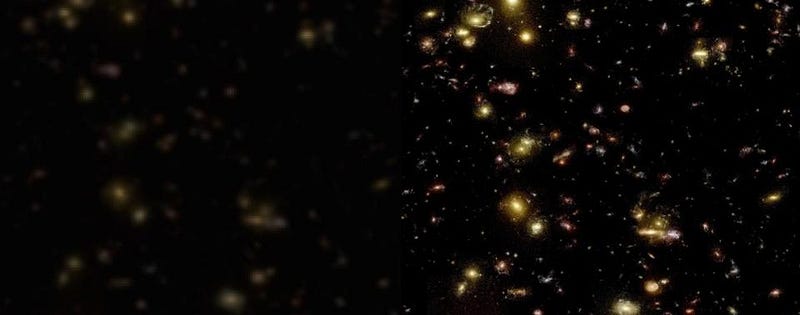
2.) The ability to finally reveal almost all of the objects that Hubble, Webb, and Roman will overlook. With LUVOIR’s size, optical capabilities, and novel instrumentation, it will surpass all previous limits in terms of what it can discover. The jump from Hubble, at the absolute limit of the faintest objects in the eXtreme Deep Field, to LUVOIR will reveal objects a whopping 40 times fainter than we can presently see. That’s the same leap from large, ground-based telescopes to Hubble, or from a 30-second exposure with a 2-meter telescope to an all-night exposure with the largest telescopes presently in the world.
- This will reveal smaller, fainter galaxies in greater numbers and at greater distances than any other observatory, ever.
- It will discover greater numbers of smaller, fainter, and more distant objects in our Solar System than every other observatory ever built, combined.
- It will take images of the outer planets that are just as good as the images taken by Voyager 1 and 2 when they physically journeyed there, and it can do so any time we choose.
- It will find, measure, and characterize individual stars fainter and farther away than ever before, including an unprecedented number in galaxies over a billion light-years away.
Basically, if you’re looking for objects that are faint, far away, small, or otherwise difficult to characterize, LUVOIR will not only find it if you know where to look, but it can tell you far more about its details than any other tool.

3.) What does any galaxy in the Universe, in detail, look like? Imagine being able to point your telescope at any galaxy in the Universe — an object typically around 100,000 light-years across — and no matter how far away it is, still being able to see features in it as small as ~300 light-years across. For a galaxy the size of the Milky Way, no matter how distant it is from us, LUVOIR would show it as at least 400 pixels across, containing over 120,000 pixels of useful, luminous information in every frame.
The same galaxy, if it were imaged with Hubble in the same amount of time, would contain only 0.06% of the information contained in a LUVOIR image, with vastly inferior resolution and light-gathering power. We could learn:
- how each galaxy we measure rotates,
- which regions in every galaxy are actively forming stars,
- what the distribution of gas and dust is in every galaxy,
- what satellite and dwarf galaxies are doing out to billions of light-years,
and so much more. From objects within our Solar System to exoplanets, stars, galaxies, and the largest cosmic structures of all, LUVOIR would answer the biggest questions we have about our Universe. All we have to do, to make our dreams of knowing what’s out there in the Universe come true, is choose to build it.
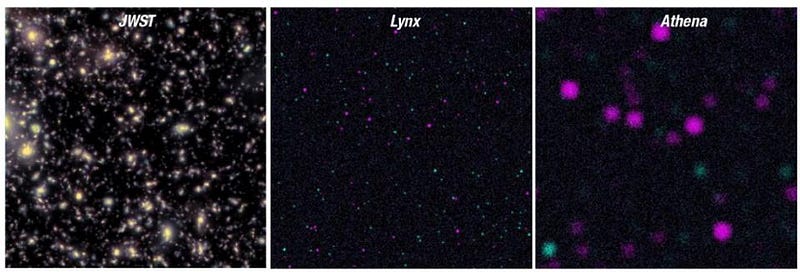
We owe the greatest space-based observatories in history to decadal surveys conducted in the recent past. They’ve brought us telescopes like Hubble, Spitzer (infrared), Chandra (X-rays), and will be bringing us the upcoming Webb and Roman telescopes as well. The current decadal survey, which charts the course for astronomy’s future in space, has four excellent options, but only one has the power to reveal whether dozens or even hundreds of potentially habitable worlds are, in fact, inhabited: LUVOIR. It’s the one observatory that could revolutionize astronomy over and over again, possibly for as long as the remainder of the 21st century.
But the ultimate hope is that we won’t just build LUVOIR — the best of the present options — but an array of observatories, one after the other, that will all cover different wavelengths and work to complement one another. Origins, a far-infrared telescope, is ideal for measuring details about planets and stars still in the process of forming. Lynx, an X-ray telescope, could reveal details about black holes, neutron stars, and colliding galaxies that nothing else can see. Even HabEx, an exoplanet-optimized mission inferior to LUVOIR in every way, could launch on a much shorter timescale, making it an attractive option.
As the head of NASA’s astrophysics division, Paul Hertz, put it, “I want all of these missions to fly. I think we should do them all; the decadal survey should tell me which one to do first.”
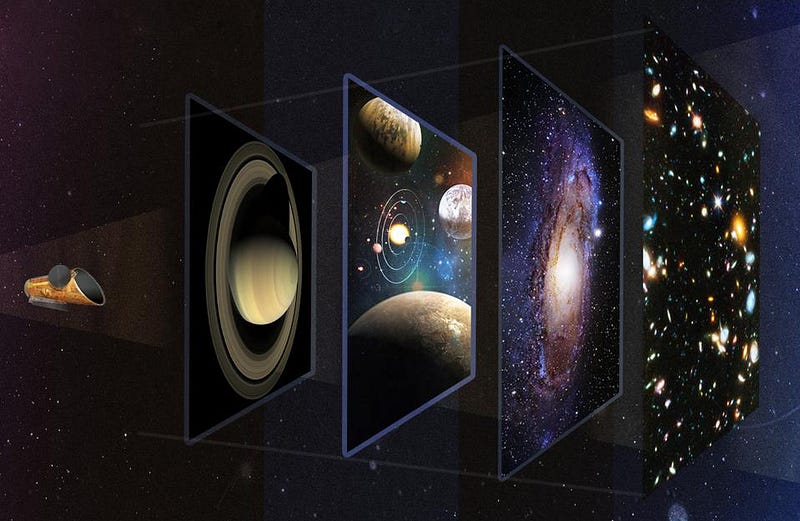
When the National Academies release their recommendations in just a few weeks, the great hope of astronomers is that at least three of these missions will be chosen to move forward, with LUVOIR, the most powerful and ambitious space-based observatory ever proposed, as the top choice. If we want definitive answers to the biggest questions of all, it takes a big effort and a substantial investment. Considering that the reward is learning that “there’s life on that planet, orbiting another star, right over there,” it’s clear that LUVOIR is the one telescope we must all join together to build.
Starts With A Bang is written by Ethan Siegel, Ph.D., author of Beyond The Galaxy, and Treknology: The Science of Star Trek from Tricorders to Warp Drive.





